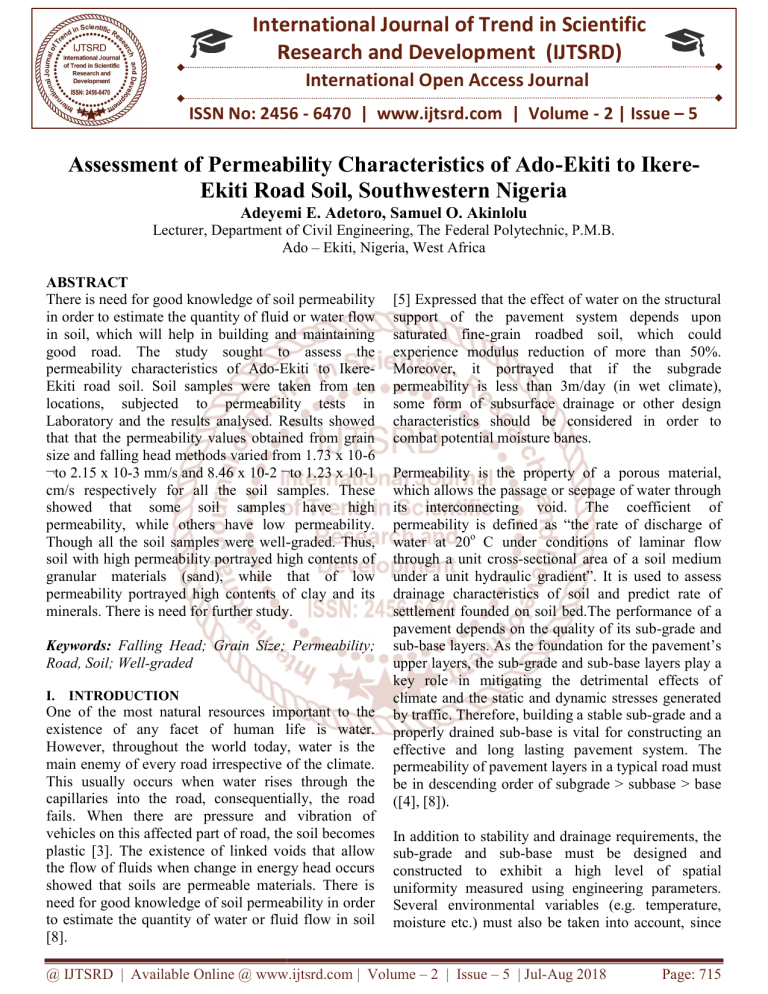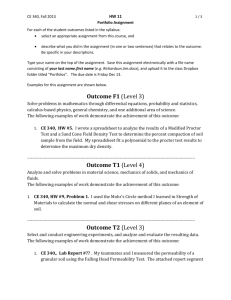
International Journal of Trend in Scientific
Research and Development (IJTSRD)
International Open Access Journal
ISSN No: 2456 - 6470 | www.ijtsrd.com | Volume - 2 | Issue – 5
Assessment of Permeability Characteristics of Ado
Ado-Ekiti
Ekiti to IkereIkere
Ekiti Road Soil, Southwestern Nigeria
Adeyemi E. Adetoro, Samuel O. Akinlolu
Lecturer, Department of Civil Engineering, The Federal Polytechnic, P.M.B.
Ado – Ekiti, Nigeria, West Africa
ABSTRACT
There is need for good knowledge of soil permeability
in order to estimate the quantity of fluid or water flow
in soil, which will help in building and maintaining
good road. The study sought to assess the
permeability characteristics of Ado-Ekiti
Ekiti to Ikere
IkereEkiti road soil. Soil samples were taken from ten
locations, subjected to permeability tests in
Laboratory
oratory and the results analysed. Results showed
that that the permeability values obtained from grain
size and falling head methods varied from 1.73 x 10
10-6
¬to 2.15 x 10-3 mm/s and 8.46 x 10-22 ¬to 1.23 x 10
10-1
cm/s respectively for all the soil samples. Th
These
showed that some soil samples have high
permeability, while others have low permeability.
Though all the soil samples were well--graded. Thus,
soil with high permeability portrayed high contents of
granular materials (sand), while that of low
permeability
ty portrayed high contents of clay and its
minerals. There is need for further study
study.
Keywords: Falling Head; Grain Size; Permeability;
Road, Soil; Well-graded
I. INTRODUCTION
One of the most natural resources important to the
existence of any facet of human life is water.
However, throughout the world today, water is the
main enemy of every road irrespective of the climate.
This usually occurs when water rises through the
capillaries into the road, consequentially, the road
fails. When there are pressuree and vibration of
vehicles on this affected part of road, the soil becomes
plastic [3]. The existence of linked voids that allow
the flow of fluids when change in energy head occurs
showed that soils are permeable materials. There is
need for good knowledge
ge of soil permeability in order
to estimate the quantity of water or fluid flow in soil
[8].
[5] Expressed that the effect of water on the structural
support of the pavement system depends upon
saturated fine-grain
grain roadbed soil, which could
experience modulus reduction of more than 50%.
Moreover, it portrayed that if the subgrade
permeability is less than 3m/day
3m/d (in wet climate),
some form of subsurface drainage or other design
characteristics should be considered in order to
combat potential moisture banes.
Permeability is the property of a porous material,
which allows the passage or seepage of water through
its interconnecting void. The coefficient of
permeability is defined as “the rate of discharge of
water at 20o C under conditions of laminar flow
through a unit cross-sectional
sectional area of a soil medium
under a unit hydraulic gradient”. It is used to assess
drainage
rainage characteristics of soil and predict rate of
settlement founded on soil bed.The
bed.
performance of a
pavement depends on the quality of its sub-grade
sub
and
sub-base
base layers. As the foundation for the pavement’s
upper layers, the sub-grade
grade and sub-base
sub
layers play a
key role in mitigating the detrimental effects of
climate and the static and dynamic stresses generated
by traffic. Therefore, building a stable sub-grade
sub
and a
properly drained sub-base
base is vital for constructing an
effective and long lasting pavement
pav
system. The
permeability of pavement layers in a typical road must
be in descending order of subgrade > subbase > base
([4], [8]).
In addition to stability and drainage requirements, the
sub-grade and sub-base
base must be designed and
constructed to exhibit
hibit a high level of spatial
uniformity measured using engineering parameters.
Several environmental variables (e.g. temperature,
moisture etc.) must also be taken into account, since
@ IJTSRD | Available Online @ www.ijtsrd.com | Volume – 2 | Issue – 5 | Jul-Aug
Aug 2018
Page: 715
International Journal of Trend in Scientific Research and Development (IJTSRD) ISSN: 2456-6470
these variables have both short and long term effects
on the geotechnical characteristics of the soil ([4],
[8]).
The effect of permeability on groundwater flow
occurs when a rock that has high porosity is not
permeable, if the pores or fractions are not connected.
The larger and better shorted the particles, the more
permeable rock or sediment tends to be. Effects of
permeability characteristics on pavement layers
performances generally depend on two interrelated
characteristics namely load bearing capacity and
volume changes. Load bearing capacity is often
affected by degree of compaction, moisture content
and soil type. While volume changes occur when
pavement layers (i.e. base, sub base and sub grade)
are exposed to excessive moisture or freezing
conditions ([4], [8]).
Permeability Tests are frequently used in the
assessment of permeability in compacted soils in
landfill and road construction. Soil permeability also
known as “Hydraulic conductivity” is measured using
many methods inclusive of Constant and Falling
Heads laboratory tests on disturbed or undisturbed
samples. During the test (s), there should be no
volume change in the soil, there should be no
compressible air present in the voids of soil i.e. soil
should be completely saturated. The flow should be
laminar and in a steady state condition. Permeability
can be measured in the field using in-situ borehole
permeability and field pumping tests. Another means
is to experimentally derive coefficients of
permeability from the results of simple laboratory
tests such as the Grain size distribution. Anyway, soil
permeability had also been estimated using Cone
penetration tests [8].
Many investigations carried out over the years for
assessment of permeability characteristics of sub
grade soil (which has been one of the criteria for road
stability) indicated that there have been no accepted
standard with reference to its characteristics
performance thus bring about questions on its
acceptability for highway construction [3].
The aim of this research work is to assess the
permeability characteristics of Ado-ekiti to Ikere-ekiti
road soil, South-western Nigeria. The test to be
carried out is permeability test, which will help in
determining the rate of flow of water/fluid in the
road’s soil. These data would be useful to Engineers
and other professionals. The coefficient of
permeability was measured using laboratory falling
head method. The measured permeability values were
compared to the values experimentally derived from
grain size distribution. Moreover, the coefficients of
permeability were obtained using correlation based on
the index soil properties of the tested soil for
comparison with the measured values.
A. Study Area
The study area is along Ado Ekiti – Ikere Ekiti road
connecting Ado – Ekiti and Ikere – Ekiti Local
Government Areas (LGAs) together. It is about 14.4
km and lies within Latitude 70 301 7.5000 N and
Longitude 50 141 5.2330 E as shown in fig. 1.
Geologically, its landscape consists of ancient plains
broken by steep sided outcropping dome rocks
situated within tropical climate of Nigeria and
underlain by metamorphic rocks of the Precambrian
basement complex of Southwestern Nigeria, which
are very ancient in age as shown in fig. 2. These
basement complex rocks showed great variations in
grain size and in mineral composition. The rocks are
quartz gneisses and schists consisting essentially of
quartz with small amounts of white mizageous
minerals. In grain size and structure, the rocks vary
from very coarse-grained pegmatite to mediumgrained gneisses ([1], [2], [7]).
The rocks are strongly foliated and occur as outcrops.
The soils derived from the basement complex rock are
mostly well drained, having medium to coarse in
texture. The geological nature of the study area and its
increased urbanisation make it more vulnerable and of
public health concern when it comes to water quality
([1], [2], [7]).
@ IJTSRD | Available Online @ www.ijtsrd.com | Volume – 2 | Issue – 5 | Jul-Aug 2018
Page: 716
International Journal of Trend in Scientific Research and Development (IJTSRD) ISSN: 2456-6470
Figure 1:: Location of the Study Area
Area- Ado-Ekiti to Ikere-Ekiti
Ekiti Road, Ekiti State, Nigeria
Figure 2:: Geology of the Study Area - Ado-Ekiti to Ikere-Ekiti Road, Ekiti State, Nigeria
II. MATERIALS AND METHODS
A. Sample Collection and Analysis
The whole stretch of the road was visually inspected
and soil samples were taken from ten pits (i.e.
locations) dug within the study area at interval of
500m and depth between 0.50m and 1.5m after topsoil
removal using method of disturbed sampling. The
soil
il samples collected were stored in polythene bag to
maintain its natural moisture contents. The samples
were then taken to the laboratory where the
deleterious materials such as roots were removed. The
samples were air dried, pulverized and large particle
particles
were removed. The coordinates of collected soil
samples locations were taken using GPS. The details
of the soil samples were as shown in Fig. 3 and Table
1. Moulding of test specimens was started as soon as
possible after completion of identification. Th
The tests
carried out on the samples were Grain Size
Distribution and Falling Head Permeability. All tests
were performed in accordance with [6] standards and
[5] specifications.
Figure 3:: Topographical Map of the Sampling
locations
ns
@ IJTSRD | Available Online @ www.ijtsrd.com | Volume – 2 | Issue – 5 | Jul-Aug
Aug 2018
Page: 717
International Journal of Trend in Scientific Research and Development (IJTSRD) ISSN: 2456-6470
Coefficient of Uniformity (Cu) was calculated from
Grain size grading curve using Hazen formula as
shown in equation (1).
For the Falling (Variable) Head permeability test,
permeability is expressed as:
K
Cu= D60/ D10
(1)
Where D60 and D10 were obtained from the grading
curve and it corresponds to the percentage passing at
60 percent and 10 percent respectively.in mm. When
Cu>5, it indicates a well graded soil, while Cu<3
indicates a uniform soil. Permeability was calculated
using McKinley formula as shown in equation (2).
K = CD250
(2)
Where K is permeability (mm/sec), C is McKinley’s
constant which is approximately 0.00357 and D 50 is
maximum diameter of the smallest 50 percent of the
sample.
= (2.303aL/A.T) Log10 (h1/h2)
(3)
Where K is the coefficient of permeability at T0C
(cm/sec.). a is the cross-sectional area of stand pipe
(cm2). L is the length of soil specimen (cm). A is the
cross-sectional area of the soil specimen (cm2). T is
the average value of t1 and t2, where t1 and t2 are the
time interval for the head to fall from h1 to h2 (secs.).
While h1 and h2 are the initial heads of water at times
t1 and t2 in the pipe above the outlet (cm) respectively
(cm). When K > 10-1 cm/sec., permeability is high, K
= 10-1 cm/sec., it is medium and K < 10-1 cm/sec., it is
low.
Table 1: The details of the soil samples
SAMPLE LOCATION
DESCRIPTION
CODE
S1
1
Sample from Bad portion of the Road near AP Filling Station
S2
2
S3
3
S4
4
S5
5
S6
6
S7
7
Sample from Bad portion of the Road inside bush along the
Road
Sample from Bad portion of the Road inside bush along the
Road
Sample from Bad portion of the Road inside bush along the
Road
Sample from Bad portion of the Road inside bush along the
Road
Sample from Good portion of the Road near APS Petrol
Filling Station
Sample from Good portion of the Road after Ado Road exit
S8
8
Sample from Good portion of the Road near OJS Oil
S9
9
Sample from Good portion of the Road near Midec Oil
S10
10
Sample from Good portion of the Road near Redeemed
Church of God
COORDINATES
Lat. 7 0 33’ 21”N
Long. 50 12’ 50”E
Lat. 70 32’ 36”N
Long. 50 13’ 07”E
Lat. 70 32’ 07”N
Long. 50 13’ 13”E
Lat. 70 31’ 35”N
Long. 50 13’ 19”E
Lat. 70 31’ 09”N
Long. 50 13’ 24”E
Lat. 70 33’ 39”N
Long. 50 12’ 45”E
Lat. 7 0 32’ 47”N
Long. 50 13’ 03”E
Lat. 7 0 31’ 54”N
Long. 50 13’ 15”E
Lat. 7 0 31’ 33”N
Long. 50 13’ 12”E
Lat. 70 31’ 10”N
Long. 50 13’ 26”E
III. RESULTS AND DISCUSSION
Table 2 shows the results of permeability and coefficient of uniformity using grain sizes for all the samples.
The permeability values obtained ranges from 1.73 x 10-6 mm/s to 2.15 x 10-3 mm/s. These indicated that their
permeability is very low (i.e. K < 10-1 cm/sec.), though well graded soil (i.e. Cu > 5). Low permeability shows
that the soil in the study area retains water, which suggests that there is presence of large contents of clay / silt
in the soil [9]. Thus, the soil becomes plastic under pressure from road surface, which might have resulted in
pavement failure in some parts of the road. The permeability of the soil samples is in descending order of S1 >
S9 > S4 > S5 > S7 > S8 > S10 > S3 > S6 > S2.
@ IJTSRD | Available Online @ www.ijtsrd.com | Volume – 2 | Issue – 5 | Jul-Aug 2018
Page: 718
International Journal of Trend in Scientific Research and Development (IJTSRD) ISSN: 2456-6470
Table 2: Results of Coefficient of Uniformity (Cu) and Permeability (K) using Grain Size Distribution
Sample
D60
D10
Cu
D50
D250
K
Grading
(mm)
(mm)
(mm)
(mm) (mm/sec)
Type
S1
0.50
0.004
128 0.250
0.60250 2.15E-03 Well graded
S2
0.57
0.066
9
0.022
0.00048 1.73E-06 Well graded
S3
0.25
0.006
45 0.100
0.01000 3.57E-05 Well graded
S4
0.29
0.040
7
0.250
0.06250 2.23E-04 Well graded
S5
0.28
0.040
7
0.200
0.04000 1.43E-04 Well graded
S6
0.06
0.001
45 0.062
0.00384 1.37E-05 Well graded
S7
0.23
0.008
31 0.190
0.03610 1.29E-04 Well graded
S8
0.28
0.003
82 0.120
0.01440 5.14E-05 Well graded
S9
0.74
0.002
493 0.310
0.09610 3.43E-04 Well graded
S10
0.70
0.002
389 0.110
0.01210 4.32E-05 Well graded
Table 3 shows the results of permeability using Falling Head method for all the samples. The permeability
values obtained ranges from 8.46 x 10-2 cm/s to 1.23 x 10-1 cm/s. These portrayed that their permeability ranges
from low to high (i.e. K < 10-1; K > 10-1 cm/sec.). S2, S3, S4 and S5 soils have high permeability, which shows
that they allow free flow of water through them. This suggested that there is presence of large contents of
granular materials in the soils e.g. sand [9]. Part of road on these soils is liable to failure due to other
Engineering factors. Additionally, their permeability is in descending order of S3 > S5 > S4 > S2. On the other
hand, S1, S6, S10, S7, S9 and S8 have low permeability, which shows that they retain water and have presence
of large contents of clay / silt materials. Road failure on these soils are likely to be as a result of high soil
plasticity, though other Engineering factors are not ruled out. Their permeability is in descending order of S1 >
S6 > S10 > S7 > S9 > S8.
Table 3: Results of Permeability Test using Falling Head method
Sample
Head
Head
t1 (Sec.)
t2
T (t2-t1) (Sec.)
Log10
(h1)
(h2)
(Sec.)
(h1/h2)
S1
110
50
2.63
7.51
4.88
0.34
S2
110
50
2.25
6.84
4.59
0.34
S3
110
50
2.54
6.48
3.94
0.34
S4
110
50
2.92
7.32
4.40
0.34
S5
110
50
2.77
6.92
4.15
0.34
S6
110
50
3.71
8.65
4.94
0.34
S7
110
50
3.54
8.92
5.38
0.34
S8
110
50
3.1
8.81
5.71
0.34
S9
110
50
3.55
9.22
5.67
0.34
S10
110
50
3.33
8.68
5.35
0.34
Generally, the results of the two methods of
permeability used were at variance with each other.
Grain size permeability method showed that all the
soil samples have low permeability while Falling head
permeability showed that the soil permeability ranges
from low to high. Nevertheless, both methods agreed
that S1, S6, S10, S7, S9 and S8 have low
permeability.
IV. Conclusion
From the above study, some soil samples (i.e. S2, S3,
S4 and S5) have high permeability, while others have
K
(cm/sec.)
9.89E-02
1.05E-01
1.23E-01
1.10E-01
1.16E-01
9.78E-02
8.98E-02
8.46E-02
8.52E-02
9.03E-02
low permeability. All the soil samples were wellgraded i.e. good representative of soil types. The
Falling head permeability method showed that the soil
permeability ranges from low to high, which
correlates with present condition of the road observed
during field assessment. Permeability from Grain size
method showed that all the soil samples have low
permeability, which portrayed high contents of clay
and its mineral in the soil of the study area. Thus, the
soil retains water. The soil samples with high
permeability portrayed high contents of granular
materials (sand), which means allowance of free flow
@ IJTSRD | Available Online @ www.ijtsrd.com | Volume – 2 | Issue – 5 | Jul-Aug 2018
Page: 719
International Journal of Trend in Scientific Research and Development (IJTSRD) ISSN: 2456-6470
of water in the soil. There is need for further study in
order to ascertain the actual causes of road failure
along the road.
References
1. Adams, J.O. and Adetoro, A. E., “Quality
Assessments of Water in Selected Waste –
Dumping Site Areas,” International Journal of
Scientific Research and Education, vol. 2(11), pp.
2399 – 2404, 2014b.
2. Adetoro, A. E. and Adams, J.O., “Analysis of
Influences of Waste – Dumping Sites on the
Quality of Water,” IOSR Journal of Mechanical
and Civil Engineering (IOSR-JMCE), vol. 11(6
ver. IV), pp. 27 – 30, 2014.
3. Bayewu O. O., Olufemi S. T. and Adewoye, A.
O., “Permeability Characteristics of some
Subgrade Soil along Highway,” International
Journal of Novel Research in Engineering and
Applied Sciences (IJNREAS), vol. 2(1), pp. 1 – 7,
2013.
4. Ifada, P. T., Kasali, I. A., Makanjuola, P. I. and
Monye, O. A. “Assessment of Permeability
Characteristics of Sub-Grade Soil along Failed
Sections of Ado-Ikere Road, South-Western
Nigeria,” Nigeria, Ado-ekiti, The Federal
Polytechnic, Dept. of Civil Engineering: HND
Dissertation (Unpublished), 2015.
5. American Association of State Highway and
Transportation
Officials
–
AASHTO,
“Classification of Soil and Soil Aggregate Mixture
for Highway Construction Purposes,” USA,
Washington DC: AASHTO, Vol. 1, 2001.
6. British Standard 1377 - BS 1377, “British
Standard Methods of Test for Soils for Civil
Engineering Purposes,” UK, London: British
Standards Institution, 1990.
7. Ekiti State Directorate of ICT, “The Official
Website of the Government of Ekiti State,
Nigeria,”
https://ekitistate.gov.ng/administration/local-govt/,
30 May,, 2018.
8. Elhakim, A. F. “Estimation of Soil Permeability,”
Alexandria Engineering Journal, vol. 55, pp. 2631
– 2638, 2016.
9. Ola,
S.A,
“Essentials
of
Geotechnical
Engineering,” Nigeria, Ibadan, Jericho: University
Press Plc, 2013.
@ IJTSRD | Available Online @ www.ijtsrd.com | Volume – 2 | Issue – 5 | Jul-Aug 2018
Page: 720




